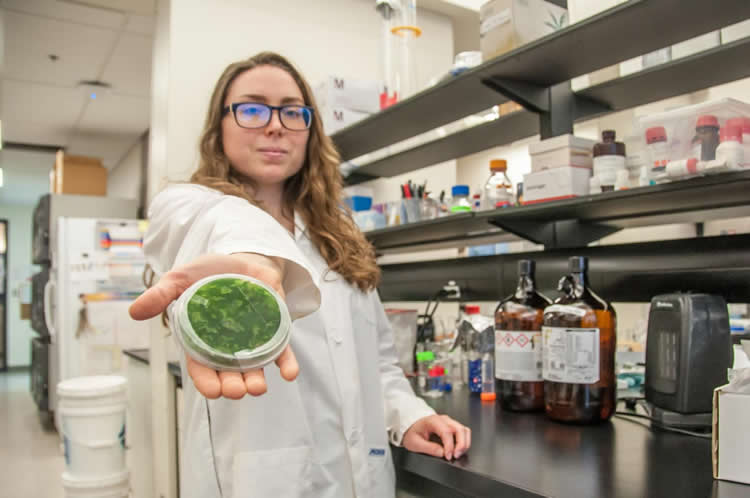Summary: Researchers have discovered a neurotoxin linked to a range of neurodegenerative diseases in Lake Winnipeg. The neurotoxin, BMAA, is found in high concentration in Cyanobacteria during periods of bloom.
Source: UBC.
A new study from UBC’s Okanagan campus has found that BMAA–a toxin linked to several neurodegenerative diseases–is present in high concentrations during cyanobacteria blooms in Lake Winnipeg.
“Cyanobacteria blooms have become increasingly common in Lake Winnipeg since the 1990s,” says Susan Murch, associate professor of chemistry at UBC Okanagan and study lead author. “These bacteria have also been known to produce BMAA under the right conditions and we wanted to establish whether this could be happening in one of Canada’s largest and most important freshwater lakes.”
Murch says BMAA has been associated with everything from Alzheimer’s to ALS and can have serious public health implications if it permeates food and water supplies.
“It’s very difficult to detect BMAA directly in water samples using current methods,” says Stephanie Bishop, graduate student in chemistry at UBC Okanagan and study co-author. “We decided to look for its presence in the cyanobacteria itself using samples collected from across the lake with the help of our partners from the Lake Winnipeg Research Consortium.”

Murch and Bishop analyzed samples collected in July and September of 2016 and found that BMAA was present in highest concentrations in the areas of the bloom that are impacted by pollution and farming.
“Agricultural and human activities along with factors like climate change are very likely behind the increased size and frequency of blooms,” Murch adds. “We now know that with these blooms comes the very real risk of increased exposure to BMAA and the public health impacts that follow.”
She warns that cyanobacterial blooms are not isolated to Lake Winnipeg and that she would expect to see similar results in other freshwater lakes.
“We’re seeing a greater number of blooms in lakes in both the US and Canada. Especially in the Great Lakes region,” she says. “It wouldn’t surprise me to see BMAA in cyanobacteria from lakes that serve a huge number of people.”
“We hope that an increased awareness of risks of BMAA along with a better understanding of the human impacts on algal blooms will help us better manage the potential consequences to public health.”
Funding: The study was published recently in Neurotoxicity Research with funding from the Natural Sciences and Engineering Research Council of Canada, the Canadian Foundation for Innovation, and the Canada Research Chairs program.
Source: Nathan Skolski – UBC
Publisher: Organized by NeuroscienceNews.com.
Image Source: NeuroscienceNews.com image is credited to UBC Okanagan.
Original Research: Abstract for “N-β-Methylamino-L-Alanine and Its Naturally Occurring Isomers in Cyanobacterial Blooms in Lake Winnipeg” by Stephanie L. Bishop, Jeff K. Kerkovius, Frederic Menard, and Susan J. Murch in Neurotoxicity Research. Published online September 30 2017 doi:10.1007/s12640-017-9820-z
[cbtabs][cbtab title=”MLA”]UBC “Neurotoxin Discovered in Lake Winnipeg.” NeuroscienceNews. NeuroscienceNews, 29 November 2017.
<https://neurosciencenews.com/lake-winnipeg-neurotoxin-8052/>.[/cbtab][cbtab title=”APA”]UBC (2017, November 29). Neurotoxin Discovered in Lake Winnipeg. NeuroscienceNews. Retrieved November 29, 2017 from https://neurosciencenews.com/lake-winnipeg-neurotoxin-8052/[/cbtab][cbtab title=”Chicago”]UBC “Neurotoxin Discovered in Lake Winnipeg.” https://neurosciencenews.com/lake-winnipeg-neurotoxin-8052/ (accessed November 29, 2017).[/cbtab][/cbtabs]
Abstract
N-β-Methylamino-L-Alanine and Its Naturally Occurring Isomers in Cyanobacterial Blooms in Lake Winnipeg
Cyanobacterial blooms have affected Lake Winnipeg since the mid-1990s due to an increased phosphorus loading into the lake, which has been exacerbated by stressors such as climate change and eutrophication. Aquatic ecosystems involving cyanobacteria have been found to contain N-β-methylamino-L-alanine (BMAA) and 2,4-diaminobutyric acid (DAB), non-protein amino acids that are associated with neurodegenerative disease, as well as two of the naturally occurring isomers, N-2(amino)ethylglycine (AEG) and β-amino-N-methylalanine (BAMA). We hypothesized that the cyanobacterial bloom in Lake Winnipeg produces BMAA and/or its naturally occurring isomers. Samples of cyanobacteria were collected by the Lake Winnipeg Research Consortium from standard sampling stations and blooms in July and September of 2016 and were analyzed for BMAA, DAB, AEG, and BAMA using previously published validated analytical methods. BMAA and BAMA were found in the highest concentration in the center of the north basin, the deepest and lowest-nitrogen zone of the lake, at an average concentration of 4 μg/g (collected in July and September 2016) and 1.5 mg/g (collected in July 2016), respectively. AEG and DAB were found in the highest concentration in cyanobacterial blooms from the nearshore region of the north basin, the slightly shallower and more nitrogen-rich zone of the lake, at 2.1 mg/g (collected in July 2016) and 0.2 mg/g (collected in July and September 2016), respectively. These findings indicate that the production of non-protein amino acids varies with the depth and nutrient contents of the bloom. It is important to note that we did not measure food or water samples directly and further study of the Lake Winnipeg food web is required to determine whether BMAA bioaccumulation represents an increased risk factor for neurodegenerative disease in the region.
“N-β-Methylamino-L-Alanine and Its Naturally Occurring Isomers in Cyanobacterial Blooms in Lake Winnipeg” by Stephanie L. Bishop, Jeff K. Kerkovius, Frederic Menard, and Susan J. Murch in Neurotoxicity Research. Published online September 30 2017 doi:10.1007/s12640-017-9820-z






